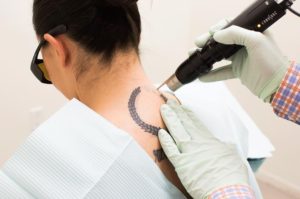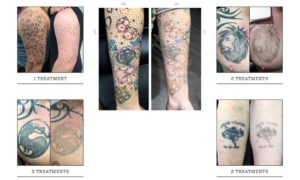09月03 What I Wish I Knew Before Starting Tattoo Removal
Here’s what you need to know about tattoo removal.
- Consider a doctor.
I’d previously had one tattoo zapped at a spa where an aesthetician used an outdated heat laser that ended up burning and scarring my skin。This time around, I’m having treatments and everything is done under medical supervision. I suggest you find your own doctor by asking friends, editors (shameless plug), and even by stopping people that you see with removal in process—which, yes, I have done.
- It will take months—if not a year or more.
Tattoos don’t just disappear after a once-over with the laser. (I wish!) I’ve had six sessions, and I’d wager that I need about five more, despite the fact that my initial estimate was six to eight sessions. It takes a long time to complete because each time the tattoo is lasered, particles are broken down and digested by the body’s immune system. The regeneration period is up to eight weeks, and the next time you go, the laser breaks down new particles of pigment. And so on and so forth.
- It’s expensive.
If you have your procedures done by a doctor, the bill for each visit can run you hundreds of dollars.Brace yourself:(ASAPS) estimates the average cost per session at $463. But see point number one for why it’s worth it.
- All ink can be taken out.
Contrary to the old belief that light, colored ink was hard to remove, Dr. Adams assured me that all hues will now disappear. ( The previous explanation was that, similar to laser hair removal, the laser would solely be attracted toward dark colors, like black.) With picosecondtechnology, he says you can even get out yellows and greens, which were previously the most stubborn.
- Get ready for needles.
Mentally prepare for visits to consist of more than just a quick and easy laser moment. Mine have been taking about 45 minutes because we take before photos, clean the areas, inject them with lidocaine for freezing, laser them, ice them, and then bandage them. Oh, and sometimes a weird thing happens where I taste metal when the laser hits my skin. Dr. Adams says it’s a sensation that some people experience when the lidocaine is hit by the laser and that it’s totally normal…but also, I might be superhuman.
6.There’s pain afterward.
And it doesn’t stop when you leave the office. I would advise that you budget for discomfort for about a week. For me, the sites blister and need to be covered in a salve and bandaged for a few days; then they start to depuff, scab, peel, and regenerate. There is good news though: The more treatments you have, the less aftercare there is (since there’s less ink reacting to the laser).
7.You’ll need things like bandages, and even clothes that don’t rest on the tattoo.
Yes, I actually bought shirts that didn’t have material where my neck/back tattoo is. At first, I was cutting tags out, but when tagless cotton tees still made the spot hurt and itch, I figured keyhole backs were a good investment. If you have tattoos on your ribs or feet (and like to wear bras and shoes) it might be best to plan your sessions accordingly.
It also helps to apply a thin coating of antibiotic ointment or healing moisturizer three times a day.For the first three days while the area is healing.
- You could just lighten ink enough to go over it.
If you don’t want to take your tattoos all the way off, you can simply lighten them enough to get some good cover-ups done. I have a friend who had a bird piece lightened enough to have a tattoo artist ink a lightbulb over the top. I thought it was smart because it meant her new tattoo didn’t have to be heavy-handed (which I’m sure you think is very 2000). - Or take it all off, but there might be white patches or scars.
If, like me, you want your ink completely removed, you should know that the skin that is left might not be flawless. I’m hoping that reading this post will prevent you from having a tattoo removal turn into scarring à la numero uno. And while the risks are nowhere near as big when you are treated by a medical professional, your skin pigment can be lightened. - But there’s another laser that can fix that.
It is picosecond laser.







No Comments